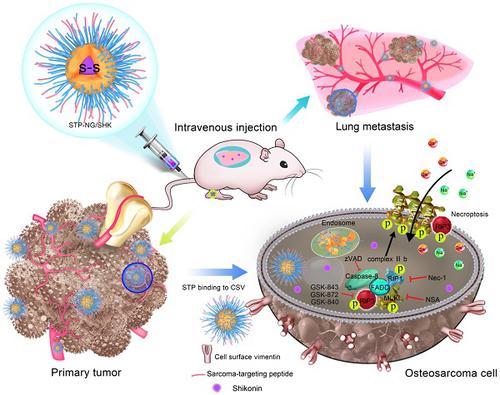当前位置:
X-MOL 学术
›
Theranostics
›
论文详情
Our official English website, www.x-mol.net, welcomes your feedback! (Note: you will need to create a separate account there.)
Targeting Tumor Hypoxia Using Nanoparticle-engineered CXCR4-overexpressing Adipose-derived Stem Cells
Theranostics ( IF 12.4 ) Pub Date : 2018-02-02 , DOI: 10.7150/thno.22736 Xinyi Jiang , Christine Wang , Sergio Fitch , Fan Yang
Theranostics ( IF 12.4 ) Pub Date : 2018-02-02 , DOI: 10.7150/thno.22736 Xinyi Jiang , Christine Wang , Sergio Fitch , Fan Yang

|
Hypoxia, a hallmark of malignant tumors, often correlates with increasing tumor aggressiveness and poor treatment outcomes. Due to a lack of vasculature, effective drug delivery to hypoxic tumor regions remains challenging. Signaling through the chemokine SDF-1α and its receptor CXCR4 plays a critical role in the homing of stem cells to ischemia for potential use as drug-delivery vehicles. To harness this mechanism for targeting tumor hypoxia, we developed polymeric nanoparticle-induced CXCR4-overexpressing human adipose-derived stem cells (hADSCs). Using glioblastoma multiforme (GBM) as a model tumor, we evaluated the ability of CXCR4-overexpressing hADSCs to target tumor hypoxia in vitro using a 2D migration assay and a 3D collagen hydrogel model. Compared to untransfected hADSCs, CXCR4-overexpressing hADSCs showed enhanced migration in response to hypoxia and penetrated the hypoxic core within tumor spheres. When injected in the contralateral brain in a mouse intracranial GBM xenograft, CXCR4-overexpressing hADSCs exhibited long-range migration toward GBM and preferentially penetrated the hypoxic tumor core. Intravenous injection also led to effective targeting of tumor hypoxia in a subcutaneous tumor model. Together, these results validate polymeric nanoparticle-induced CXCR4-overexpressing hADSCs as a potent cellular vehicle for targeting tumor hypoxia, which may be broadly useful for enhancing drug delivery to various cancer types.
中文翻译:

使用过表达纳米颗粒的CXCR4脂肪干细胞靶向肿瘤缺氧。
缺氧是恶性肿瘤的标志,通常与肿瘤侵袭性增加和治疗效果差有关。由于缺乏脉管系统,向缺氧肿瘤区域的有效药物递送仍然具有挑战性。通过趋化因子SDF-1α及其受体CXCR4发出的信号在干细胞归巢到缺血中可能起药物递送载体的作用中起着至关重要的作用。为了利用这种针对肿瘤缺氧的机制,我们开发了聚合物纳米粒子诱导的CXCR4过表达的人类脂肪来源的干细胞(hADSCs)。使用多形性胶质母细胞瘤(GBM)作为模型肿瘤,我们使用2D迁移测定法和3D胶原水凝胶模型评估了CXCR4过表达的hADSCs在体外靶向肿瘤缺氧的能力。与未转染的hADSC相比,过度表达CXCR4的hADSCs响应缺氧而增强迁移,并穿透肿瘤球体内的缺氧核心。当在小鼠颅内GBM异种移植物中注射到对侧脑中时,过表达CXCR4的hADSCs向GBM迁移并优先穿透缺氧的肿瘤核心。静脉注射还导致皮下肿瘤模型中肿瘤缺氧的有效靶向。在一起,这些结果验证了聚合物纳米粒子诱导的过表达CXCR4的hADSCs是靶向肿瘤缺氧的有效细胞载体,可广泛用于增强向各种癌症类型的药物递送。过度表达CXCR4的hADSCs向GBM迁移并优先穿透缺氧性肿瘤核心。静脉注射还导致皮下肿瘤模型中肿瘤缺氧的有效靶向。在一起,这些结果验证了聚合物纳米粒子诱导的过表达CXCR4的hADSCs是靶向肿瘤缺氧的有效细胞载体,可广泛用于增强向各种癌症类型的药物递送。过度表达CXCR4的hADSCs向GBM迁移并优先穿透缺氧性肿瘤核心。静脉注射还导致皮下肿瘤模型中肿瘤缺氧的有效靶向。在一起,这些结果验证了聚合物纳米粒子诱导的过表达CXCR4的hADSCs是靶向肿瘤缺氧的有效细胞载体,可广泛用于增强向各种癌症类型的药物递送。
更新日期:2018-05-01
中文翻译:

使用过表达纳米颗粒的CXCR4脂肪干细胞靶向肿瘤缺氧。
缺氧是恶性肿瘤的标志,通常与肿瘤侵袭性增加和治疗效果差有关。由于缺乏脉管系统,向缺氧肿瘤区域的有效药物递送仍然具有挑战性。通过趋化因子SDF-1α及其受体CXCR4发出的信号在干细胞归巢到缺血中可能起药物递送载体的作用中起着至关重要的作用。为了利用这种针对肿瘤缺氧的机制,我们开发了聚合物纳米粒子诱导的CXCR4过表达的人类脂肪来源的干细胞(hADSCs)。使用多形性胶质母细胞瘤(GBM)作为模型肿瘤,我们使用2D迁移测定法和3D胶原水凝胶模型评估了CXCR4过表达的hADSCs在体外靶向肿瘤缺氧的能力。与未转染的hADSC相比,过度表达CXCR4的hADSCs响应缺氧而增强迁移,并穿透肿瘤球体内的缺氧核心。当在小鼠颅内GBM异种移植物中注射到对侧脑中时,过表达CXCR4的hADSCs向GBM迁移并优先穿透缺氧的肿瘤核心。静脉注射还导致皮下肿瘤模型中肿瘤缺氧的有效靶向。在一起,这些结果验证了聚合物纳米粒子诱导的过表达CXCR4的hADSCs是靶向肿瘤缺氧的有效细胞载体,可广泛用于增强向各种癌症类型的药物递送。过度表达CXCR4的hADSCs向GBM迁移并优先穿透缺氧性肿瘤核心。静脉注射还导致皮下肿瘤模型中肿瘤缺氧的有效靶向。在一起,这些结果验证了聚合物纳米粒子诱导的过表达CXCR4的hADSCs是靶向肿瘤缺氧的有效细胞载体,可广泛用于增强向各种癌症类型的药物递送。过度表达CXCR4的hADSCs向GBM迁移并优先穿透缺氧性肿瘤核心。静脉注射还导致皮下肿瘤模型中肿瘤缺氧的有效靶向。在一起,这些结果验证了聚合物纳米粒子诱导的过表达CXCR4的hADSCs是靶向肿瘤缺氧的有效细胞载体,可广泛用于增强向各种癌症类型的药物递送。



























 京公网安备 11010802027423号
京公网安备 11010802027423号